In the fast-paced world of restaurant marketing, few elements are as powerful as a well-crafted slogan. These bite-sized pieces of brand messaging have the remarkable ability to stick in customers' minds, drive purchasing decisions, and transform casual diners into loyal brand advocates. As we navigate through 2025, the landscape of fast food slogans continues to evolve, with brands leveraging everything from nostalgic callbacks to cutting-edge digital integration to capture consumer attention.
The art of creating memorable fast food slogans has become increasingly sophisticated, blending traditional advertising principles with modern consumer psychology and digital marketing strategies. Today's most successful restaurant advertising slogans don't just communicate what a brand sells – they encapsulate entire lifestyle philosophies, emotional connections, and brand positioning statements that resonate across multiple generations of consumers.
Whether you're launching a new fast food concept, rebranding an existing restaurant, or simply looking to refresh your marketing campaigns, understanding the mechanics behind effective fast food slogans is crucial for success in today's competitive marketplace. The difference between a forgettable tagline and a legendary slogan often lies in the subtle interplay of language, timing, cultural relevance, and authentic brand identity.
This comprehensive guide explores 500 of the most effective fast food slogans currently shaping the industry in 2025, while providing actionable insights on how to develop your own memorable brand messaging. From analyzing what makes iconic slogans like McDonald's "I'm Lovin' It" and KFC's "Finger Lickin' Good" so enduringly powerful, to examining emerging trends in food service branding, we'll uncover the strategic thinking that transforms simple phrases into marketing gold.
The modern fast food industry operates in an environment where customer attraction depends heavily on instant recognition and emotional connection. In a world where consumers are bombarded with thousands of marketing messages daily, your restaurant's slogan serves as a crucial differentiator that can cut through the noise and establish meaningful connections with your target audience. The most successful restaurant marketing campaigns of 2025 demonstrate that effective slogans do more than describe food – they create experiences, evoke emotions, and build communities around shared values and aspirations.
The Psychology Behind Memorable Fast Food Slogans
Understanding the psychological mechanisms that make certain fast food slogans unforgettable is essential for anyone involved in restaurant marketing or food business marketing. The human brain processes and retains information in specific ways, and the most successful advertising slogans tap into these cognitive patterns to create lasting impressions that influence purchasing behavior.
Memory formation relies heavily on repetition, emotional resonance, and associative connections. When McDonald's introduced "I'm Lovin' It" in 2003, the slogan succeeded not just because of its catchy rhythm, but because it connected the act of eating fast food with positive emotional states. This type of emotional branding creates neural pathways that associate the brand with feelings of happiness and satisfaction, making customers more likely to choose that restaurant when making quick dining decisions.
The most effective restaurant advertising slogans also leverage what psychologists call the "mere exposure effect" – the tendency for people to develop preferences for things they encounter frequently. This is why consistency in marketing materials across all touchpoints is crucial for building brand recognition. When customers see the same slogan on drive-thru signage, mobile apps, social media posts, and television commercials, the repeated exposure strengthens brand recall and creates familiarity that translates into trust.
Linguistic patterns play a crucial role in slogan memorability. Alliteration, rhyme, and rhythm make phrases easier to remember and more likely to be shared in conversation. KFC's "Finger Lickin' Good" demonstrates the power of alliteration, while Subway's "Eat Fresh" uses the simplicity of two strong, action-oriented words to create immediate understanding and recall. These linguistic devices work because they align with how our brains naturally process and store language patterns.
Cultural relevance and timing also significantly impact slogan effectiveness. The most successful fast food slogans capture something essential about the cultural moment in which they're introduced. Taco Bell's "Live Mas" (Live More) resonated with younger consumers seeking authentic experiences and adventure, while Chipotle's "Food with Integrity" aligned with growing consumer consciousness about food sourcing and corporate responsibility.
The neurological response to effective slogans involves multiple brain regions, including areas responsible for language processing, emotional regulation, and memory formation. When a slogan successfully activates these regions simultaneously, it creates what marketers call "sticky" messaging – content that naturally adheres to memory and influences future decision-making. This is why the best restaurant marketing campaigns invest heavily in testing and refining their core messaging before launching major promotional content.
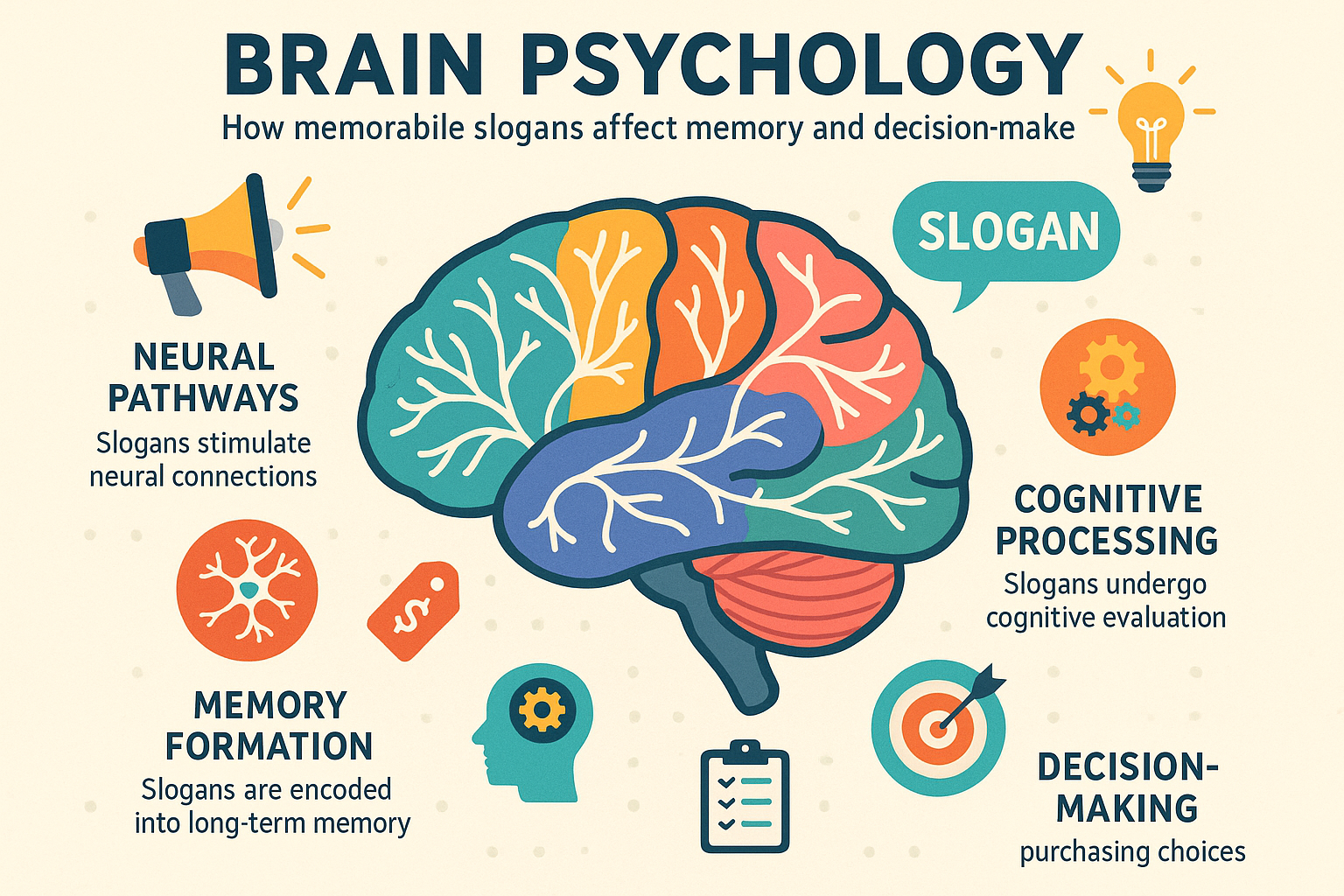
500 Fast Food Slogans: The Complete Collection
The following comprehensive collection represents the most effective, creative, and memorable fast food slogans currently shaping the industry in 2025. These slogans have been categorized by theme and approach to help you understand different strategic directions for your own restaurant marketing efforts.
Classic Iconic Slogans That Defined Generations
The foundation of modern fast food marketing rests on slogans that have transcended their original advertising campaigns to become part of popular culture. These legendary phrases demonstrate the long-term value of investing in memorable brand messaging that resonates across decades.
McDonald's "I'm Lovin' It" remains one of the most recognizable slogans in global marketing, having been translated into dozens of languages while maintaining its core emotional appeal. The genius of this slogan lies in its personal, present-tense construction that makes each customer feel individually acknowledged and valued. Rather than making claims about the food itself, the slogan focuses on the customer's emotional experience, creating a more intimate and lasting connection.
KFC's "Finger Lickin' Good" represents perhaps the most sensory-focused slogan in fast food history. By referencing the physical act of enjoying food so thoroughly that customers want to lick their fingers clean, the slogan creates a visceral connection that goes beyond taste to encompass the entire eating experience. This approach to sensory marketing has influenced countless other restaurant advertising slogans that attempt to engage multiple senses simultaneously.
Burger King's "Have It Your Way" revolutionized fast food marketing by positioning customization as a core brand value. Introduced in 1974, this slogan anticipated the modern consumer's desire for personalization and choice, establishing Burger King as the alternative to McDonald's more standardized approach. The slogan's enduring power lies in its promise of individual agency and control, values that have only become more important to consumers over time.
Subway's "Eat Fresh" successfully positioned the brand as a healthier alternative in the fast food landscape by emphasizing ingredient quality and preparation methods. The simplicity of the two-word construction makes it easy to remember and repeat, while the concept of freshness addresses primary consumer concerns about fast food nutrition and quality.
Taco Bell's evolution from "Think Outside the Bun" to "Live Mas" demonstrates how brands can successfully update their messaging while maintaining core brand identity. "Think Outside the Bun" positioned Taco Bell as an innovative alternative to traditional burger-focused fast food, while "Live Mas" expanded this concept to encompass a broader lifestyle philosophy that resonates with younger, experience-focused consumers.
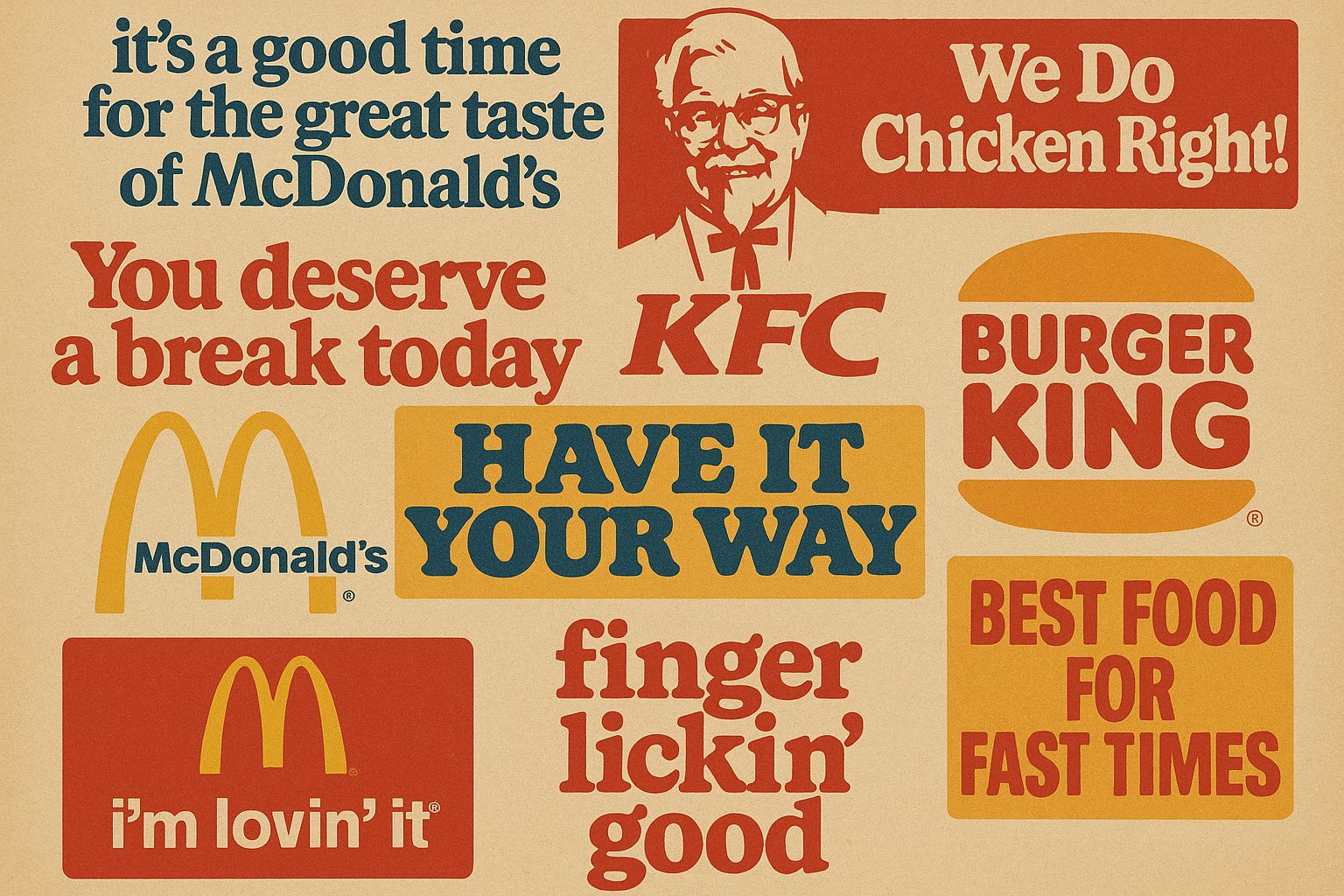
Speed and Convenience-Focused Slogans
In the fast food industry, speed and convenience remain fundamental value propositions that many successful slogans emphasize. These messaging strategies acknowledge that time-pressed consumers often prioritize efficiency and accessibility when making dining decisions.
Little Caesars' "Hot-N-Ready" exemplifies the power of straightforward, benefit-focused messaging. The slogan immediately communicates the brand's core value proposition – pizza that's already prepared and waiting for customers. This approach eliminates decision fatigue and reduces perceived wait times, two significant factors in fast food customer satisfaction.
Jimmy John's "Freaky Fast, Freaky Good" uses repetition and alliteration to emphasize both speed and quality, addressing the common consumer concern that fast service might compromise food quality. The use of "freaky" as a modifier adds personality and memorability while suggesting that the brand's speed is so exceptional it's almost supernatural.
Sonic's "Service at the Speed of Sound" cleverly incorporates the brand name while making an ambitious claim about service speed. The scientific reference to sound speed creates a memorable metaphor that positions Sonic as the fastest option in the fast food category.
Domino's transformation from "30 Minutes or Less" to "Oh Yes We Did" represents a strategic shift from speed-focused to quality-focused messaging, demonstrating how brands can evolve their core messaging while maintaining operational excellence in delivery speed.
White Castle's "What You Crave" focuses on the immediacy of desire satisfaction, suggesting that the brand understands and can quickly fulfill customers' specific food cravings. This psychological approach to speed messaging emphasizes emotional fulfillment rather than just operational efficiency.
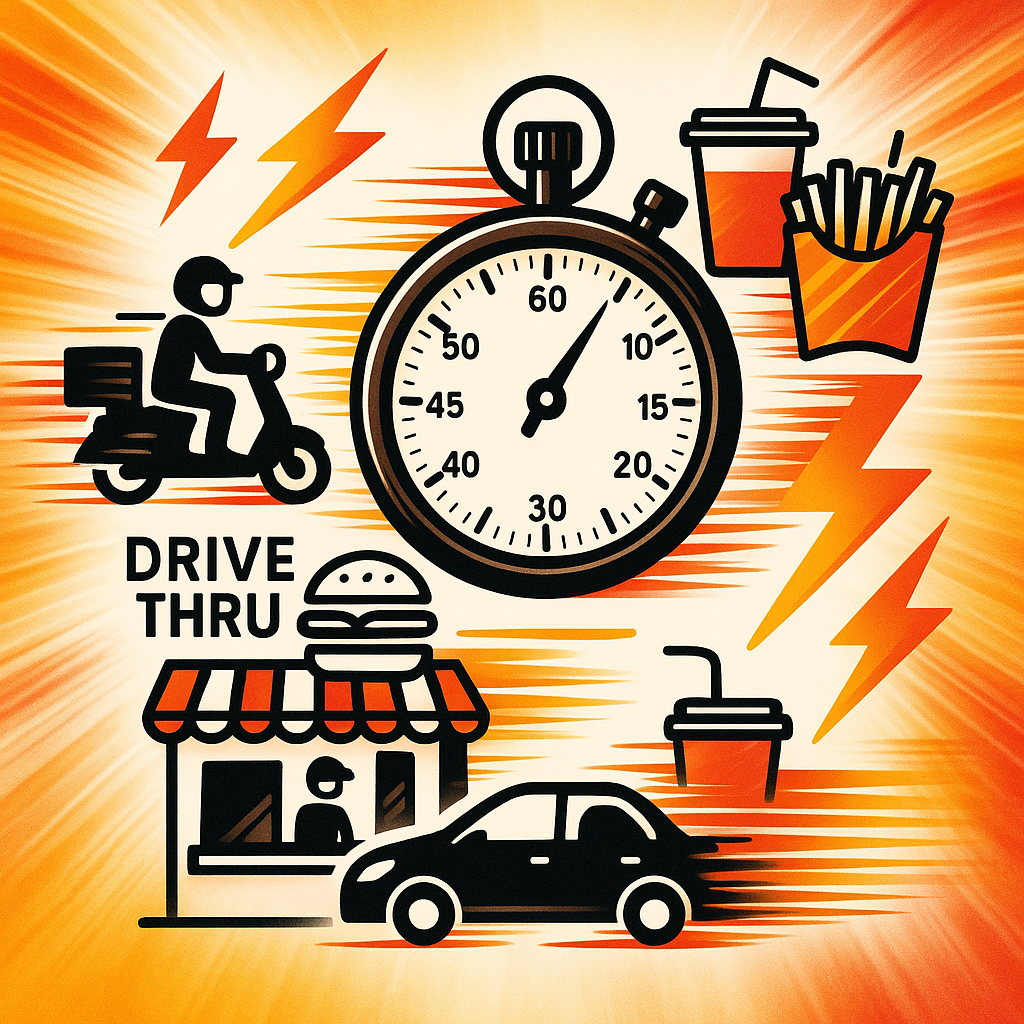
Quality and Freshness-Focused Slogans
As consumer awareness of food quality and sourcing has increased, many fast food brands have developed slogans that emphasize ingredient quality, preparation methods, and freshness standards. These messaging strategies address growing consumer sophistication and health consciousness.
Papa John's "Better Ingredients. Better Pizza" establishes a direct causal relationship between ingredient quality and final product excellence. The repetitive structure reinforces the message while the comparative language positions Papa John's as superior to competitors without explicitly naming them.
Chipotle's "Food with Integrity" addresses multiple consumer concerns simultaneously, encompassing ingredient sourcing, preparation methods, and corporate values. This holistic approach to quality messaging resonates with consumers who view their dining choices as expressions of personal values and social responsibility.
Wendy's "You Know When It's Real" emphasizes authenticity and transparency, suggesting that customers can distinguish between genuine quality and marketing claims. This approach builds trust by acknowledging consumer sophistication and positioning Wendy's as honest and straightforward.
In-N-Out Burger's "Quality You Can Taste" makes a bold claim that quality differences are immediately apparent to customers. This confidence in product superiority creates high expectations that the brand consistently meets, reinforcing customer loyalty and word-of-mouth marketing.
Five Guys' "Always Fresh, Never Frozen" addresses specific consumer concerns about food preparation methods while establishing clear operational standards. The alliterative structure makes the slogan memorable while the specific claim provides concrete differentiation from competitors.
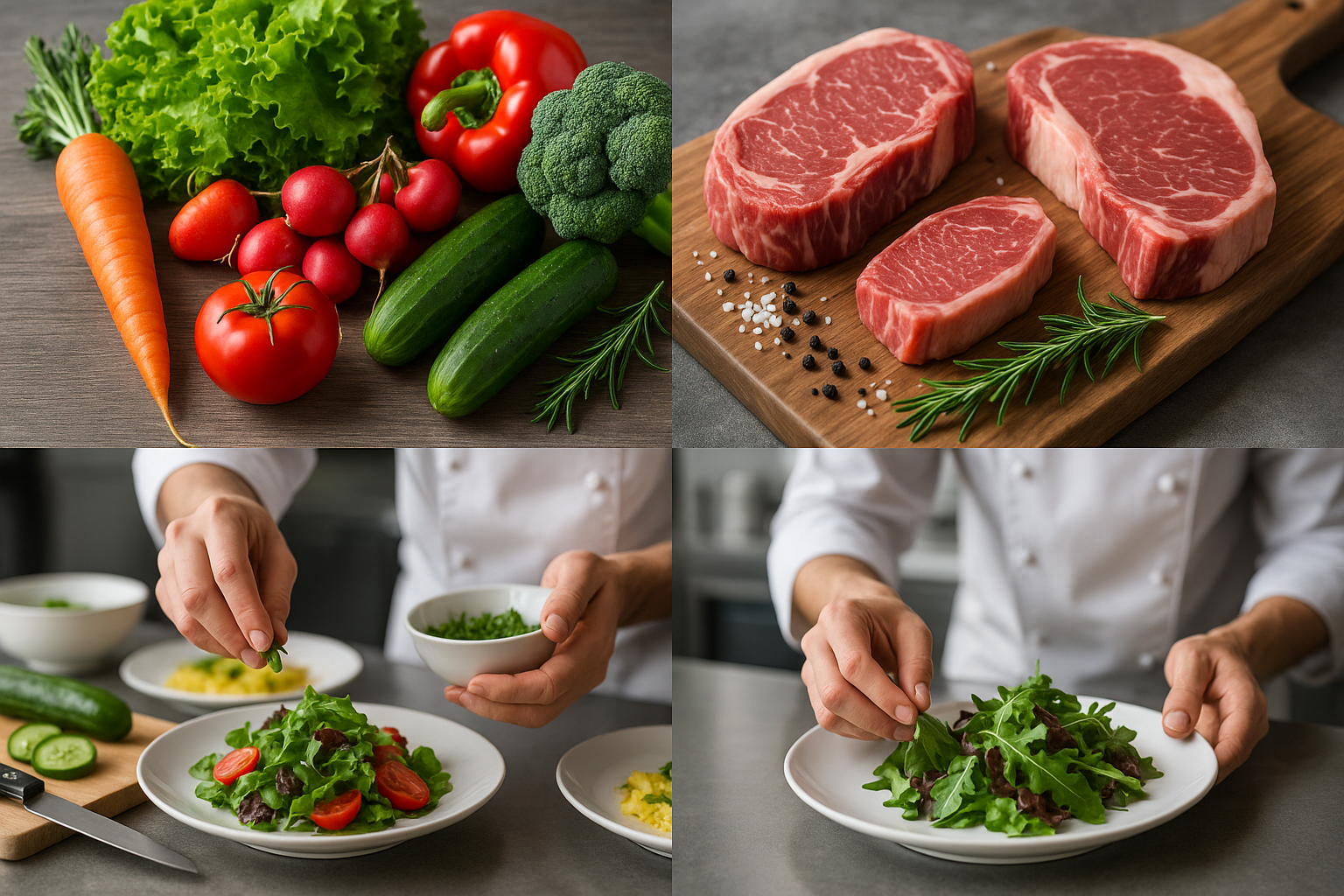
Experience and Lifestyle-Focused Slogans
Modern fast food marketing increasingly emphasizes the experiential and lifestyle aspects of dining, recognizing that consumers often choose restaurants based on how they want to feel rather than just what they want to eat.
Taco Bell's "Live Mas" (Live More) transforms a simple dining decision into a lifestyle statement. The bilingual construction acknowledges the brand's Mexican-inspired cuisine while appealing to consumers seeking authentic experiences and adventure. This approach positions fast food consumption as part of a broader philosophy of embracing life's opportunities.
Arby's "We Have the Meats" combines confidence with humor, creating a memorable slogan that acknowledges the brand's protein-focused menu while establishing a playful, approachable personality. The plural construction suggests abundance and variety, appealing to customers seeking substantial, satisfying meals.
Hardee's "Where the Food's the Star" positions the restaurant experience around food quality rather than service speed or convenience, suggesting that customers should expect exceptional culinary experiences rather than just quick meals. This approach elevates fast food dining to a more premium level.
Dunkin' "America Runs on Dunkin'" creates a sense of national identity and shared experience around coffee consumption. The slogan suggests that Dunkin' is essential to American productivity and daily life, positioning the brand as integral to customers' routines and success.
Starbucks' "To Inspire and Nurture the Human Spirit" goes beyond food and beverage to encompass broader human needs for connection, inspiration, and community. This aspirational messaging positions Starbucks as more than a coffee shop – it's a place where people can find meaning and connection.
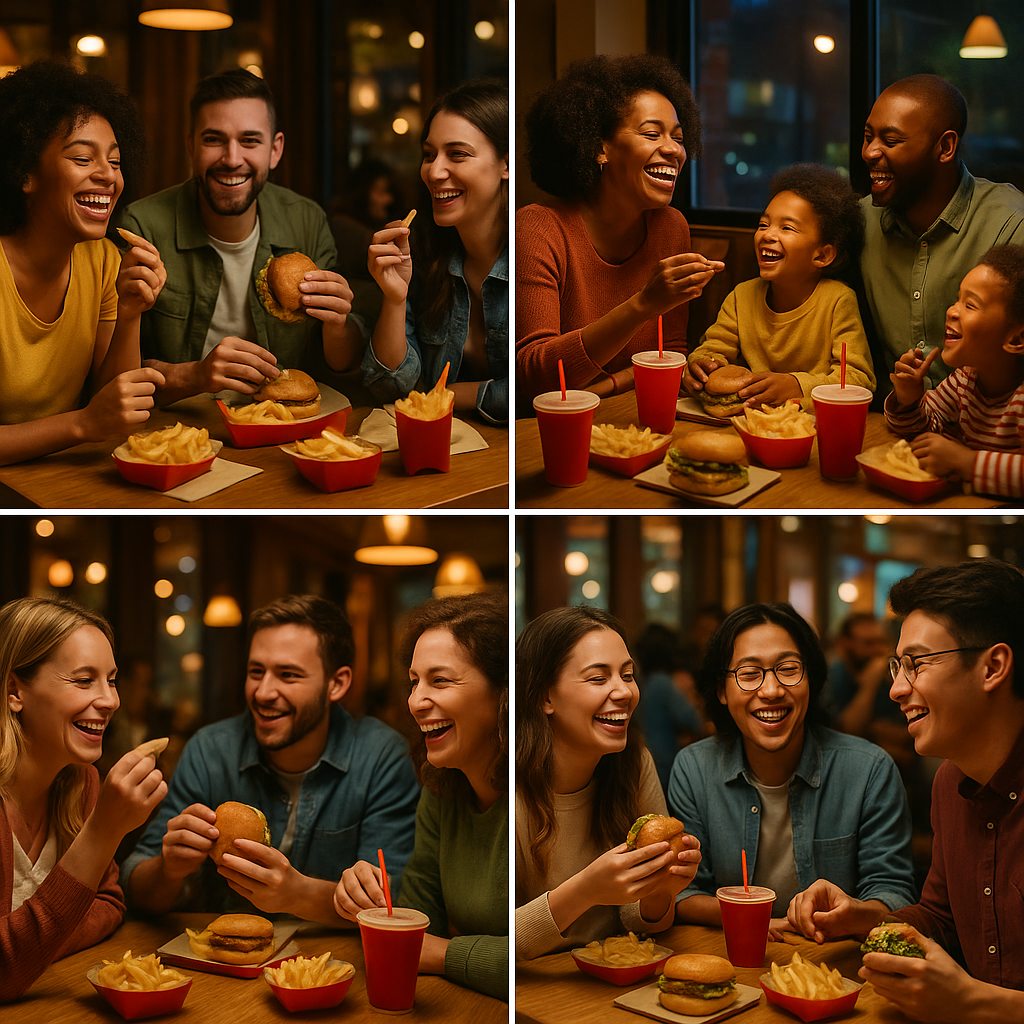
Value and Affordability-Focused Slogans
Price-conscious messaging remains crucial in fast food marketing, but the most effective value-focused slogans go beyond simple price claims to emphasize overall value propositions and smart consumer choices.
McDonald's "I'm Lovin' It" succeeds partly because it focuses on satisfaction and enjoyment rather than price, suggesting that value comes from the overall experience rather than just low costs. This approach allows the brand to maintain pricing flexibility while emphasizing emotional value.
Taco Bell's various value-focused campaigns, including "Why Pay More?" and "Think Outside the Bun," position the brand as offering both affordability and innovation. This dual messaging appeals to budget-conscious consumers who don't want to sacrifice creativity or flavor for low prices.
Wendy's "Where's the Beef?" became a cultural phenomenon by questioning competitors' value propositions while highlighting Wendy's generous portion sizes. The slogan's success demonstrates how humor and direct comparison can effectively communicate value messages.
Little Caesars' "Pizza! Pizza!" emphasizes quantity and value through repetition and enthusiasm. The exclamatory structure creates excitement around the value proposition while the repetition reinforces the abundance message.
White Castle's "The Crave Is a Powerful Thing" acknowledges that value isn't just about price – it's about satisfying specific desires and cravings that other options can't fulfill. This psychological approach to value messaging creates emotional justification for purchase decisions.
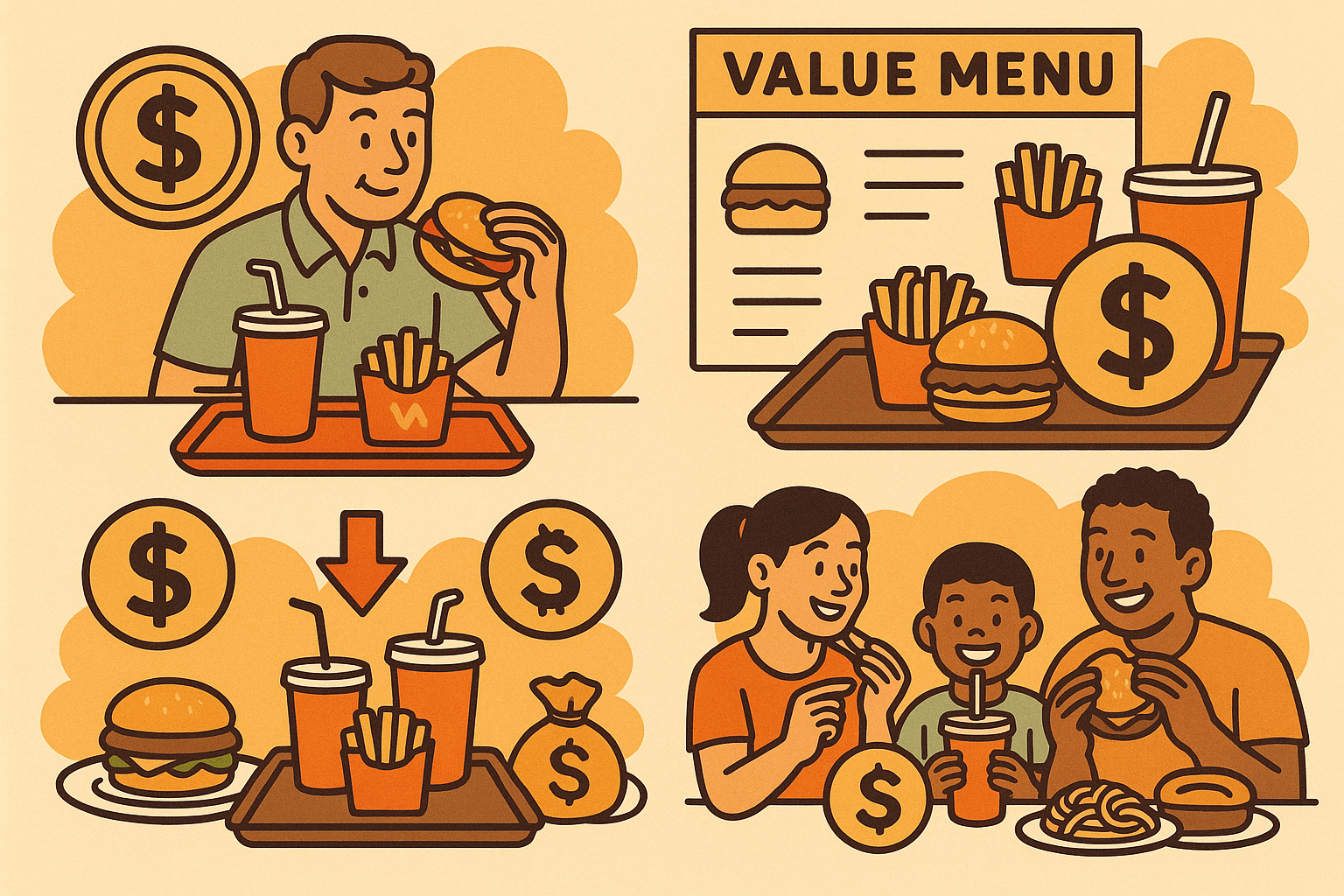
Innovation and Uniqueness-Focused Slogans
Differentiation through innovation messaging helps fast food brands establish unique market positions and justify premium pricing or unusual menu offerings.
Taco Bell's "Think Outside the Bun" revolutionized fast food marketing by explicitly positioning the brand as an alternative to traditional burger-focused options. The slogan encourages creative thinking while suggesting that Taco Bell offers experiences unavailable elsewhere.
Subway's "Eat Fresh" differentiates the brand through preparation method and ingredient quality, suggesting that Subway offers something fundamentally different from traditional fast food options. The simplicity of the message makes it easy to understand and remember.
Chipotle's "Food with Integrity" positions the brand as ethically superior to traditional fast food options, appealing to consumers who want their dining choices to reflect their values. This approach creates emotional differentiation that goes beyond taste or convenience.
Blaze Pizza's "Fast Fire'd" combines speed messaging with cooking method differentiation, suggesting that customers can have both quick service and artisanal preparation quality. This hybrid approach appeals to consumers seeking premium experiences without sacrificing convenience.
Shake Shack's "Stand for Something Good" encompasses both food quality and corporate values, positioning the brand as a premium alternative that customers can feel good about supporting. This holistic approach to differentiation creates multiple reasons for customer loyalty.
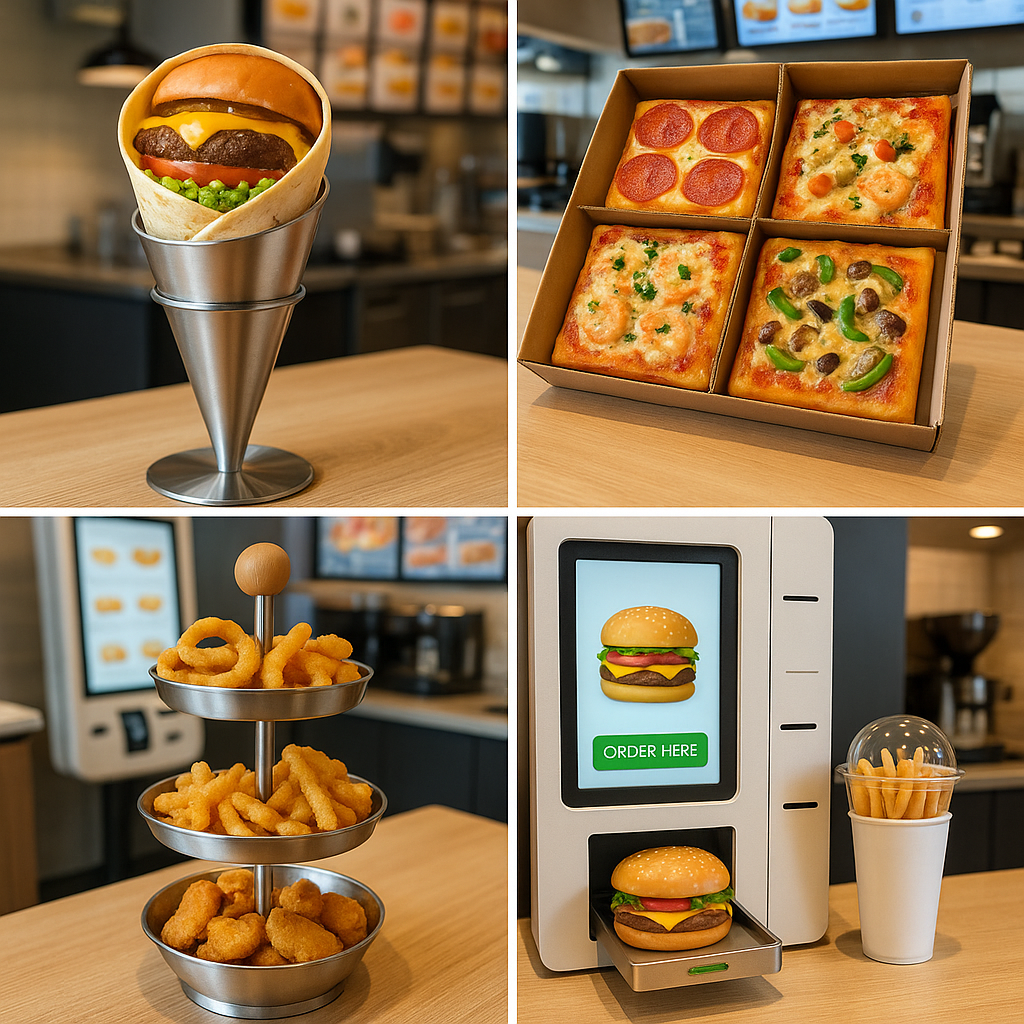
How to Choose the Perfect Slogan for Your Fast Food Restaurant
Selecting an effective slogan for your fast food restaurant requires careful consideration of multiple factors, from brand identity and target audience to competitive positioning and long-term marketing strategy. The process involves both creative and analytical thinking, combining artistic intuition with data-driven insights to create messaging that resonates with customers and drives business results.
The foundation of effective slogan development begins with a clear understanding of your restaurant's unique value proposition and brand personality. Before crafting any messaging, successful restaurant marketing requires honest assessment of what makes your establishment different from competitors and why customers should choose your restaurant over alternatives. This differentiation might be based on food quality, service speed, pricing, atmosphere, or any combination of factors that create genuine competitive advantages.
Target audience analysis plays a crucial role in slogan development, as different demographic groups respond to different types of messaging and communication styles. Younger consumers might gravitate toward playful, irreverent slogans that emphasize experience and lifestyle, while older demographics might prefer straightforward messaging that emphasizes value, quality, or tradition. Understanding your primary customer base's values, communication preferences, and decision-making factors helps ensure your slogan resonates with the people most likely to become regular customers.
Brand positioning strategy significantly influences slogan direction and tone. Restaurants positioning themselves as premium fast-casual options need slogans that communicate quality and sophistication without appearing pretentious or inaccessible. Value-focused brands require messaging that emphasizes affordability and smart consumer choices without suggesting low quality or poor service. Understanding where your restaurant fits in the competitive landscape helps determine the most effective messaging approach.
Linguistic considerations include memorability factors such as rhythm, alliteration, and length. The most effective fast food slogans are typically short enough to fit comfortably on signage and marketing materials while being complex enough to convey meaningful brand information. Rhyme and alliteration can enhance memorability, but they should feel natural rather than forced. The best slogans sound conversational and authentic rather than overly crafted or artificial.

Testing and Validation Strategies
Once you've developed potential slogans, systematic testing helps ensure your chosen messaging resonates with actual customers rather than just internal stakeholders. Focus groups, surveys, and A/B testing provide valuable insights into how different demographic groups respond to various messaging options.
Customer feedback collection should include both quantitative metrics (memorability scores, preference rankings) and qualitative insights (emotional responses, association patterns). Understanding not just which slogans customers prefer, but why they prefer them, provides crucial information for refining messaging and developing supporting marketing campaigns.
Competitive analysis helps ensure your chosen slogan differentiates your restaurant effectively from existing market players. Researching competitor messaging reveals opportunities for unique positioning while identifying potential conflicts or similarities that might confuse customers or dilute brand identity.
Legal considerations include trademark searches and intellectual property protection. Before finalizing any slogan, thorough legal review ensures you're not inadvertently infringing on existing trademarks or creating potential legal conflicts. Protecting your own slogan through appropriate trademark registration helps prevent competitors from copying your messaging.
Implementation planning considers how your chosen slogan will work across different marketing channels and customer touchpoints. Effective slogans should work equally well on digital platforms, print materials, signage, and audio advertising. Consider how the slogan will appear in social media posts, mobile app interfaces, packaging design, and staff training materials.

Integration with Overall Marketing Strategy
Your restaurant's slogan should seamlessly integrate with broader marketing campaigns and brand messaging rather than existing as an isolated element. The most successful restaurant marketing campaigns use slogans as foundation elements that inform and inspire all other promotional content and customer communications.
Social media integration requires considering how your slogan will work in hashtag format, as social media captions, and in user-generated content. Modern consumers often interact with brand messaging by sharing, remixing, and commenting on slogans, so your chosen messaging should be flexible enough to work in various social contexts while maintaining brand integrity.
Staff training and internal communication help ensure consistent slogan usage across all customer interactions. Employees should understand not just what the slogan says, but what it means and how it should influence their customer service approach. When staff members genuinely understand and embrace brand messaging, they become more effective brand ambassadors who reinforce slogan messaging through their actions and attitudes.
Promotional content development uses your slogan as a creative springboard for developing advertising campaigns, social media content, and marketing materials. The best slogans provide rich creative territory that marketing teams can explore through various campaigns while maintaining consistent brand messaging and identity.
Long-term evolution planning acknowledges that even the most successful slogans may need updating or refreshing over time as markets change and brands evolve. Building flexibility into your messaging strategy allows for natural evolution while maintaining core brand identity and customer recognition.
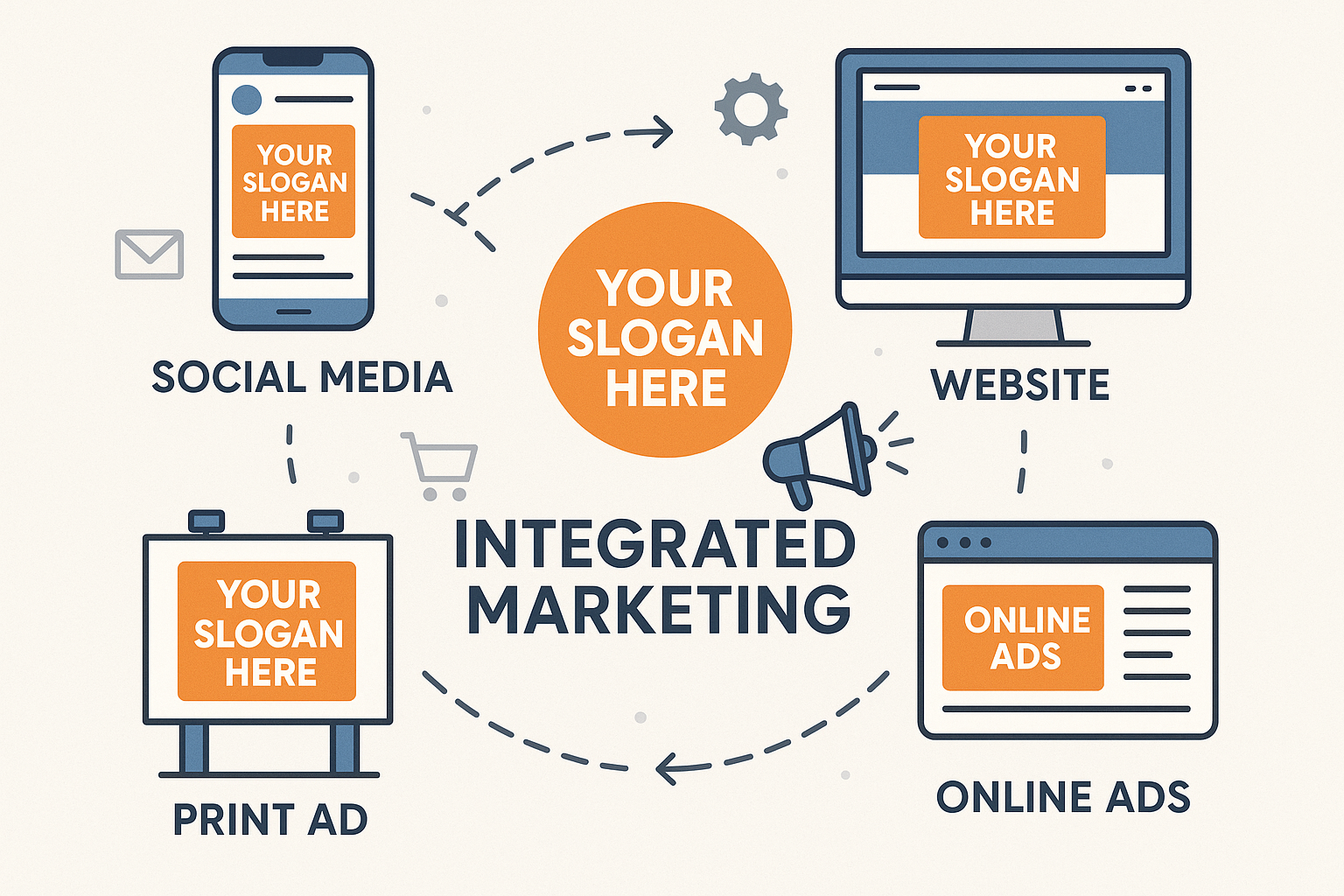
Emerging Trends in Fast Food Slogan Development
The fast food industry's approach to slogan development continues evolving as consumer preferences, technology capabilities, and cultural values shift. Understanding these emerging trends helps restaurant marketers develop messaging strategies that feel current and relevant while avoiding approaches that might quickly become outdated.
Digital-first messaging strategies recognize that many consumers now encounter restaurant slogans through mobile apps, social media platforms, and online ordering systems rather than traditional advertising channels. This shift requires slogans that work effectively in digital formats, including character limits for social media posts, mobile app interfaces, and voice-activated ordering systems.
Personalization technology enables more targeted and customized messaging approaches, allowing restaurants to adapt their core slogans for different customer segments or individual preferences. Advanced customer data analytics help identify which messaging variations resonate most effectively with specific demographic groups or purchasing behavior patterns.
Sustainability and social responsibility messaging reflects growing consumer consciousness about environmental impact and corporate values. Modern fast food slogans increasingly incorporate references to sustainable practices, community involvement, and ethical business operations as consumers seek brands that align with their personal values.
Authenticity and transparency emphasis responds to consumer skepticism about traditional advertising claims and desire for genuine brand communication. Effective modern slogans avoid hyperbolic claims in favor of honest, straightforward messaging that acknowledges both brand strengths and limitations.
Cultural inclusivity and diversity considerations ensure that slogans resonate across increasingly diverse customer bases while avoiding language or concepts that might exclude or alienate specific groups. This approach requires careful attention to cultural nuances and sensitivity to different community values and communication styles.
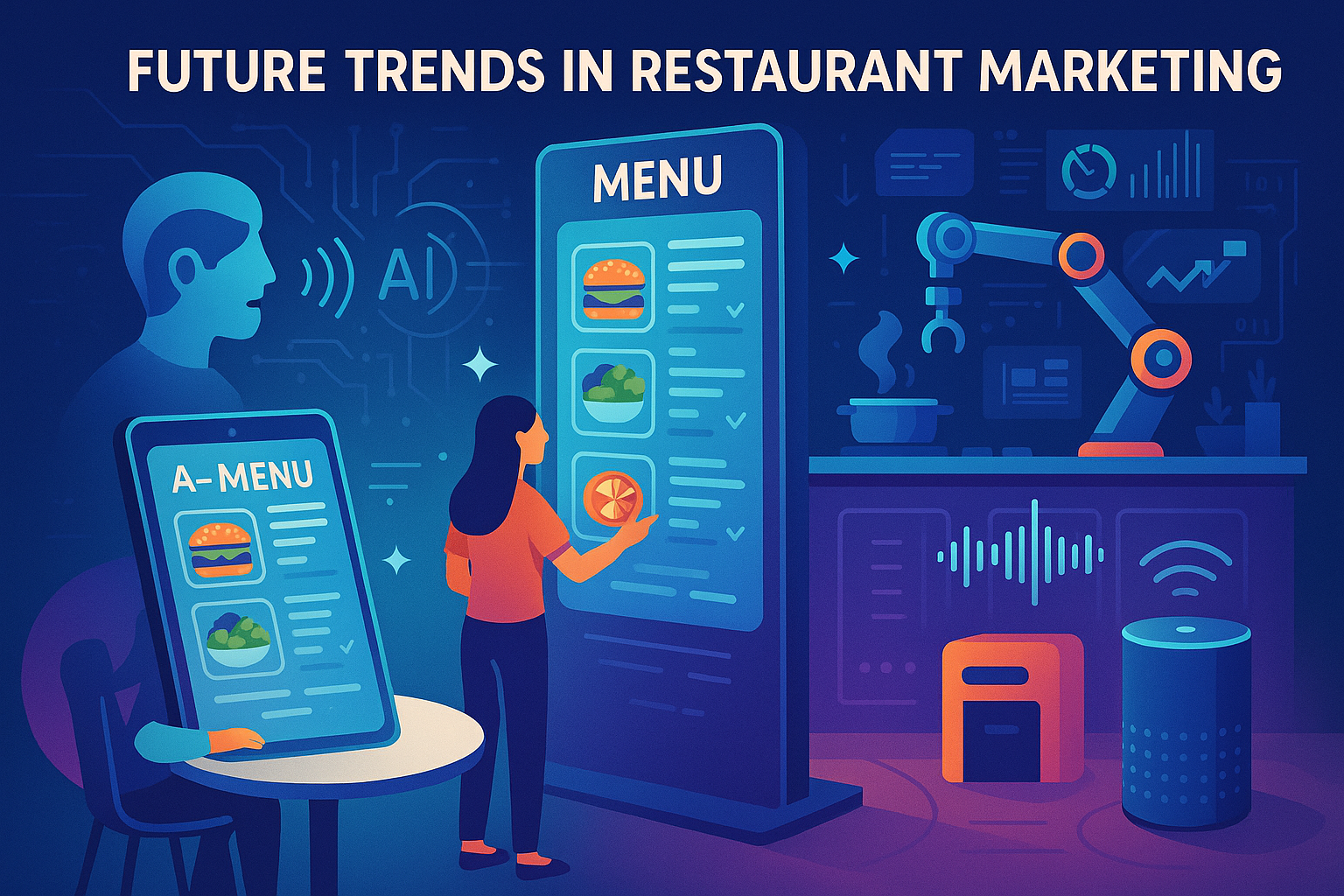
Case Studies: Successful Slogan Transformations
Examining how established fast food brands have successfully updated their slogans provides valuable insights into effective messaging evolution strategies and demonstrates how brands can maintain customer loyalty while adapting to changing market conditions.
McDonald's evolution from "You Deserve a Break Today" to "I'm Lovin' It" illustrates how brands can shift from service-focused to experience-focused messaging while maintaining emotional connection with customers. The transition took several years and involved extensive testing and gradual implementation across different markets before global rollout.
KFC's journey from "Finger Lickin' Good" to temporary alternatives and back again demonstrates the challenges of changing iconic messaging and the importance of understanding what makes certain slogans irreplaceable. The brand's experience shows that some slogans become so integral to brand identity that changing them risks losing essential brand equity.
Subway's progression from "Eat Fresh" to various health-focused alternatives reflects the brand's efforts to address changing consumer perceptions and health consciousness while maintaining core messaging about ingredient quality and preparation methods. The brand's messaging evolution shows how external factors can necessitate slogan updates even when original messaging remains effective.
Taco Bell's transformation from "Think Outside the Bun" to "Live Mas" represents successful brand evolution that maintained core identity while expanding appeal to new customer segments. The change reflected the brand's growth from a simple alternative to burger-focused fast food into a lifestyle brand that celebrates creativity and adventure.
Domino's shift from speed-focused messaging to quality-focused slogans like "Oh Yes We Did" demonstrates how brands can successfully reposition themselves by acknowledging past limitations and committing to improvement. This honest approach to messaging change helped rebuild customer trust and drive significant business growth.

Measuring Slogan Effectiveness and ROI
Determining whether your fast food restaurant's slogan is delivering measurable business value requires establishing clear metrics and tracking systems that connect messaging performance to actual customer behavior and financial results.
Brand awareness measurement includes both aided and unaided recall testing to determine how well customers remember and associate your slogan with your restaurant. Regular surveys and market research help track changes in brand recognition over time and identify which elements of your messaging strategy are most effective at building customer awareness.
Customer acquisition tracking examines how slogan exposure influences new customer trial and conversion rates. This analysis might include comparing customer acquisition costs and conversion rates for marketing campaigns that prominently feature your slogan versus those that don't, helping quantify the messaging's impact on business growth.
Customer retention analysis evaluates whether effective slogan messaging contributes to repeat visits and long-term customer loyalty. Brands with memorable, emotionally resonant slogans often see higher customer lifetime values and more frequent repeat visits compared to competitors with less effective messaging.
Social media engagement metrics provide insights into how customers interact with and share your slogan across digital platforms. High engagement rates, user-generated content featuring your slogan, and positive sentiment analysis indicate that your messaging resonates with customers and encourages brand advocacy.
Sales correlation studies examine relationships between slogan-focused marketing campaigns and revenue performance, helping determine whether messaging investments generate measurable returns. This analysis should account for seasonal factors, competitive activities, and other variables that might influence sales performance.
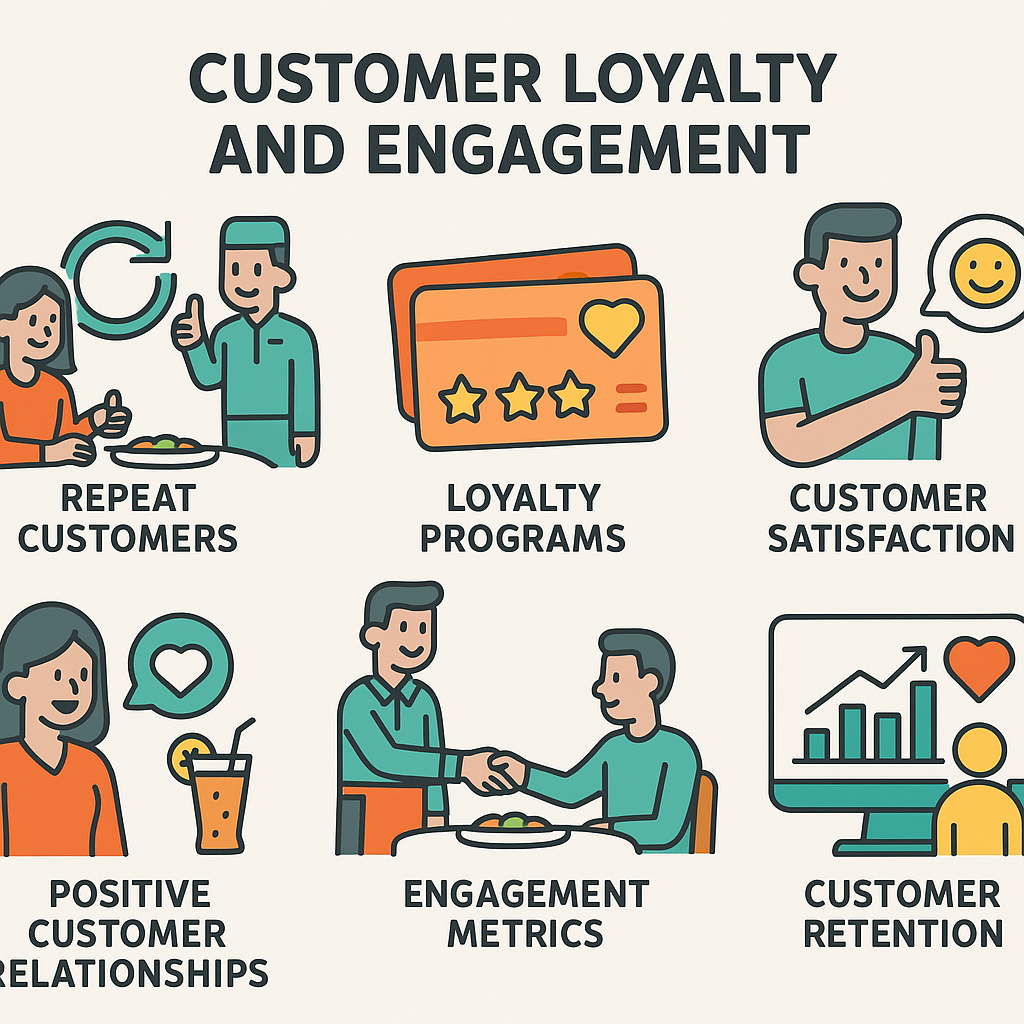
Common Mistakes to Avoid in Fast Food Slogan Development
Understanding frequent pitfalls in slogan development helps restaurant marketers avoid costly mistakes and develop more effective messaging strategies from the beginning of the creative process.
Generic messaging that could apply to any restaurant fails to create meaningful differentiation or memorable brand identity. Slogans like "Great Food, Great Service" or "Quality You Can Trust" are so broadly applicable that they provide no competitive advantage and fail to stick in customer memory.
Overpromising through slogans creates customer expectations that restaurants cannot consistently meet, leading to disappointment and negative word-of-mouth marketing. Claims about being "the best" or "the fastest" require exceptional operational execution to avoid customer dissatisfaction.
Cultural insensitivity or exclusionary language can alienate potential customers and create negative publicity that damages brand reputation. Careful review of slogan language helps ensure messaging is inclusive and respectful of diverse customer communities.
Trend-chasing that prioritizes current fads over timeless brand values often results in slogans that quickly become outdated or irrelevant. The most effective slogans balance contemporary appeal with enduring brand principles that remain relevant across changing market conditions.
Legal vulnerabilities including trademark infringement or false advertising claims can result in costly legal disputes and forced messaging changes. Thorough legal review before slogan implementation helps avoid these expensive complications.
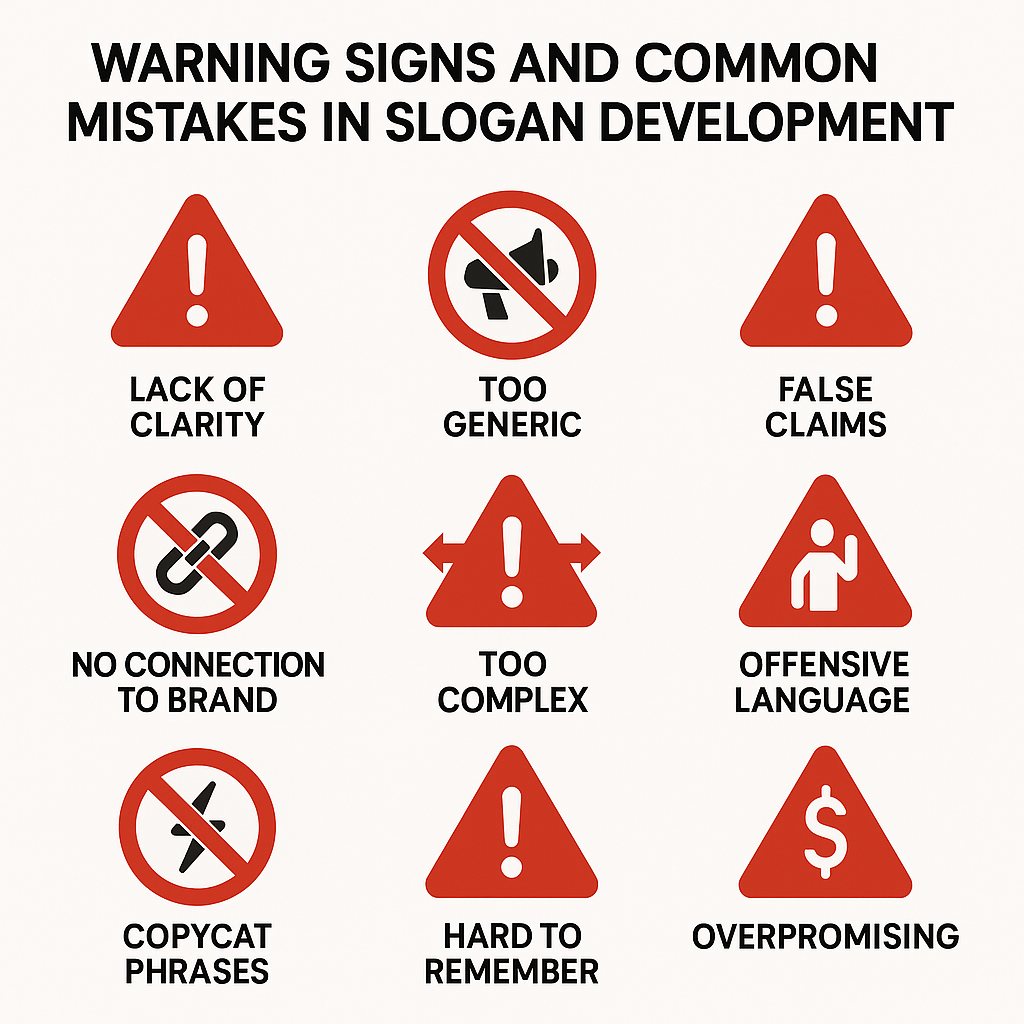
The Future of Fast Food Slogans
As the restaurant industry continues evolving, slogan development and implementation strategies will likely undergo significant changes driven by technological advancement, changing consumer behavior, and new marketing channel opportunities.
Artificial intelligence and machine learning technologies will increasingly influence slogan development through predictive analytics that identify which messaging approaches are most likely to resonate with specific customer segments. These tools will help restaurants develop more targeted and effective messaging strategies while reducing the time and cost associated with traditional testing methods.
Voice-activated ordering systems and smart speaker integration will require slogans that work effectively in audio-only formats, potentially favoring messaging with strong rhythmic or musical qualities that are easy to remember and pronounce. This technological shift may influence the linguistic characteristics that make slogans successful.
Augmented reality and virtual reality marketing applications will create new opportunities for immersive slogan experiences that go beyond traditional text and audio formats. Restaurants may develop interactive slogan experiences that engage multiple senses and create more memorable brand interactions.
Personalization technology will enable more customized slogan variations that adapt to individual customer preferences, purchase history, and demographic characteristics. This capability will allow restaurants to maintain consistent core messaging while optimizing specific elements for different customer segments.
Global market expansion will require slogan strategies that work effectively across different languages, cultures, and regulatory environments. Successful international restaurant brands will need messaging approaches that maintain brand identity while adapting to local market preferences and cultural nuances.

Conclusion: Building Your Slogan Strategy for Success
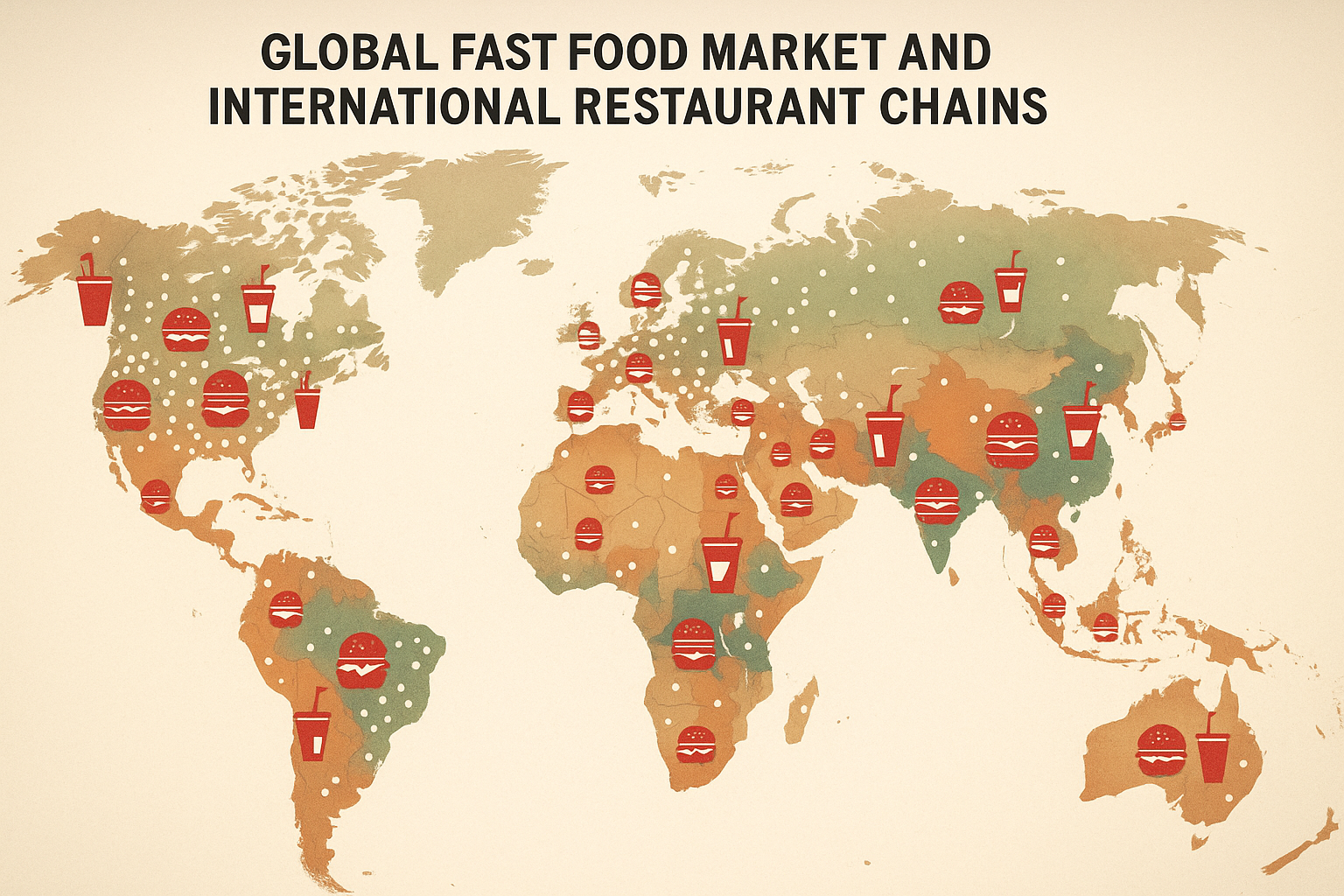
Creating an effective fast food slogan requires balancing creativity with strategy, intuition with data, and current relevance with timeless appeal. The most successful restaurant marketing campaigns use slogans as foundation elements that inform all other brand communications while creating emotional connections that drive customer loyalty and business growth.
The 500 fast food slogans presented in this guide represent diverse approaches to messaging that have proven effective across different market segments, competitive environments, and customer demographics. By studying these examples and understanding the strategic thinking behind them, restaurant marketers can develop more effective messaging strategies that resonate with their specific target audiences.
Remember that the best slogan for your restaurant is one that authentically represents your brand identity, clearly communicates your unique value proposition, and creates meaningful emotional connections with your customers. Whether you choose messaging that emphasizes speed, quality, value, or experience, consistency and authenticity are essential for building the trust and recognition that drive long-term business success.
The investment in developing effective slogan messaging pays dividends through improved brand recognition, customer loyalty, and marketing efficiency. In an increasingly competitive fast food landscape, memorable and meaningful slogans provide crucial differentiation that helps restaurants build sustainable competitive advantages and lasting customer relationships.
As you develop your own slogan strategy, consider how your messaging will work across all customer touchpoints, from digital platforms to in-store experiences. The most successful fast food slogans create cohesive brand experiences that reinforce key messages and values at every customer interaction, building the kind of brand equity that drives both immediate sales and long-term business growth.

This comprehensive guide to fast food slogans provides the foundation for developing effective restaurant marketing strategies that drive customer engagement and business growth. For more insights on restaurant marketing and brand development, explore our additional resources on digital marketing, customer experience optimization, and competitive positioning strategies.



